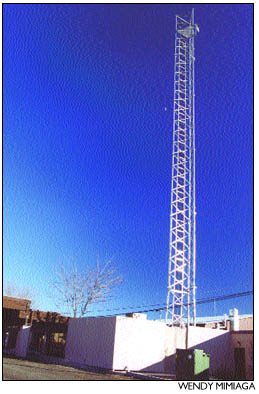|
Jan. 6, 2001 By Janelle Holden
The highly visible edifice to technology rising above Montezuma Avenue for the past year has yet to produce the technological renaissance its owners promised. Derek Torinus, a sales manager for REANET, the telecommunications company that constructed the tower, said that there is currently "limited commercial traffic" originating from the tower, which provides wireless Internet services. REANET is a for-profit telecommunications subsidiary of Empire Electric and La Plata Electric Associations. When asked what businesses were currently using the tower, Torinus admitted that the tower currently serviced only one test business in the area. The Cortez City Council passed a conditional-use permit for the tower’s construction in August 1999 — despite the objections of local residents. The permit was granted on the condition that REANET, formerly Tri-Corners Communications, Inc., would construct and implement line-of-sight microwave technology within the year. At the meeting, former TCT agent Raymond Keith explained that the tower would provide "bridge technology" to businesses and government entities until the town is wired for fiber-optic transmissions. Citizens complained at the lengthy public hearing that the tower would detract from one of the city’s most aesthetic boulevards. But the project was portrayed as a necessary evil if the city wanted its residents to enjoy the benefits of cutting-edge technology. Since then, the tower has served "a couple of customers," according to Torinus, but will be used to its full capacity soon. Torinus says the tower will be used soon to increase the coverage area that will otherwise be served by the out-of-town high-speed fiber connections the company plans to connect to this year. "We plan to be rolling out on services with that wireless equipment to the Cortez community in whole early this year," explained Torinus. "Once we have out-of-town connectivity we will ultimately hook up all our infrastructure in that area to that fiber-optic line, providing unlimited bandwidth in the Cortez area, and with this we can offer a lot more products." The 120-foot telecommunications tower currently houses some wireless antennas used to broadcast Internet services to a receiver-transmitter at the customer’s end. The wireless technology is limited by a line-of-sight requirement between the customer and the antennae, but Torinus said the tower would help provide faster Internet service to rural customers unable to benefit from the fiber optic highway by any other means. A fiber-optics highway stretching from Grand Junction to Albuquerque with connections at Durango and Cortez has been completed by Pathnet, and is expected to be used to provide telecommunications services by mid-winter. |
||
|
Copyright © 2001 the Cortez Journal.
All rights reserved. |
